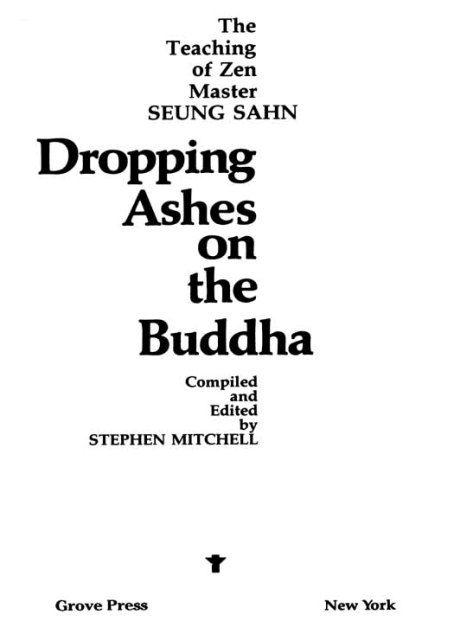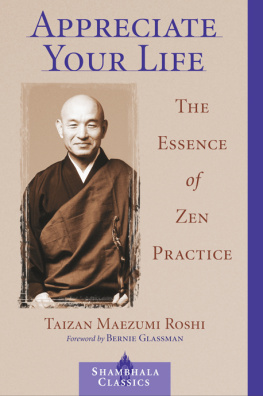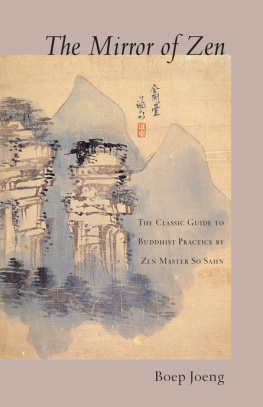



Copyright 1976 by The Providence Zen Center, Inc.
All rights reserved. No part of this book may be reproduced in any form or by any electronic or mechanical means, or the facilitation thereof, including information storage and retrieval systems, without permission in writing from the publisher, except by a reviewer, who may quote brief passages in a review. Any members of educational institutions wishing to photocopy part or all of the work for classroom use, or publishers who would like to obtain permission to include the work in an anthology, should send their inquiries to Grove/Atlantic, Inc., 841 Broadway, New York, NY 10003.
Published simultaneously in Canada
Printed in the United States of America
Library of Congress Catalog Card Number 75-37236
ISBN-13: 9780802195470
Designed by Steven A. Baron
Grove Press
an imprint of Grove/Atlantic, Inc.
841 Broadway
New York, NY 10003
Distributed by Publishers Group West
www.groveatlantic.com
The Providence Zen Center, Inc.
528 Pound Road
Cumberland, RI 02864
07 08 09 10 20 19 18 17 16
Table of Contents
Preface
Zen teaching is like a window. At first, we look at it, and see only the dim reflection of our own face. But as we learn, and our vision becomes clear, the teaching becomes clear. Until at last it is perfectly transparent. We see through it. We see all things: our own face.
This book is a collection of Seung Sahn Soen-sa's teaching in Americadialogues, stories, formal Zen interviews, Dharma Speeches, and letters. The words arise as situations arise. Each situation is a game, and a matter of life and death.
The title comes from a problem which Soen-sa gives his students for homework. It goes like this:
Somebody comes into the Zen Center with a lighted cigarette, walks up to the Buddha-statue, blows smoke in its face and drops ashes on its lap. You are standing there. What can you do?
This person has understood that nothing is holy or unholy. All things in the universe are one, and that one is himself. So everything is permitted. Ashes are Buddha; Buddha is ashes. The cigarette flicks. The ashes drop.
But his understanding is only partial. He has not yet understood that all things are just as they are. Holy is holy; unholy is unholy. Ashes are ashes; Buddha is Buddha. He is very attached to emptiness and to his own understanding, and he thinks that all words are useless. So whatever you say to him, however you try to teach him, he will hit you. If you try to teach by hitting him back, he will hit you even harder. (He is very strong.)
How can you cure his delusion?
Since you are a Zen student, you are also a Zen teacher. You are walking on the path of the Bodhisattva, whose vow is to save all beings from their suffering. This person is suffering from a mistaken view. You must help him understand the truth: that all things in the universe are just as they are.
How can you do this?
If you find the answer to this problem, you will find the true way.
Zen Master Seung Sahn is properly written about as Soen-sa (Zen Master; equivalent to Zenji in Japanese) and addressed or spoken about as Soen-sa-nim ( nim being the honorific particle in Korean). Soen is pronounced somewhat like sun, but further back in the throat; sa rhymes with ha; nim sounds like neem. In his name, the vowel in S eu ng is like the vowel in l oo k.
Introduction
Deep in the mountains, the great temple bell is struck. You hear it reverberating in the morning air, and all thoughts disappear from your mind. There is nothing that is you; there is nothing that is not you. There is only the sound of the bell, filling the whole universe.
Springtime comes. You see the flowers blossoming, the butterflies flitting about; you hear the birds singing, you breathe in the warm weather. And your mind is only springtime. It is nothing at all.
You visit Niagara and take a boat to the bottom of the Falls. The downpouring of the water is in front of you and around you and inside you, and suddenly you are shouting: YAAAAAA!
In all these experiences, outside and inside have become one. This is Zen mind.
Original nature has no opposites. Speech and words are not necessary. Without thinking, all things are exactly as they are. The truth is just like this.
Then why do we use words? Why have we made this book?
According to Oriental medicine, when you have a hot sickness you should take hot medicine. Most people are very attached to words and speech. So we cure this sickness with word-and-speech medicine.
Most people have a deluded view of the world. They don't see it as it is; they don't understand the truth. What is good, what is bad? Who makes good, who makes bad? They cling to their opinions with all their might. But everybody's opinion is different. How can you say that your opinion is correct and somebody else's is wrong? This is delusion.
If you want to understand the truth, you must let go of your situation, your condition, and all your opinions. Then your mind will be before thinking. Before thinking is clear mind. Clear mind has no inside and no outside. It is just like this. Just like this is the truth.
An eminent teacher said,
If you want to pass through this gate,
do not give rise to thinking.
This means that if you are thinking, you can't understand Zen. If you keep the mind that is before thinking, this is Zen mind.
So another Zen Master said,
Everything the Buddha taught
was only to correct your thinking.
If already you have cut off thinking,
what good are the Buddha's words?
The Heart Sutra says, Form is emptiness, emptiness is form. This means, no form, no emptiness. But the true meaning of no form, no emptiness is, form is form, emptiness is emptiness.
If you are thinking, you won't understand these words. If you are not thinking, just like this is Buddha-nature.
What is Buddha-nature?
Deep in the mountains, the great temple bell is struck.
The truth is just like this.
Seung Sahn

1. Zen Is Understanding Yourself
One day a student from Chicago came to the Providence Zen Center and asked Seung Sahn Soen-sa, What is Zen?
Soen-sa held his Zen stick above his head and said, Do you understand?
The student said, I don't know.
Soen-sa said, This don't-know mind is you. Zen is understanding yourself.
What do you understand about me? Teach me.
Soen-sa said, In a cookie factory, different cookies are baked in the shape of animals, cars, people, and airplanes. They all have different names and forms, but they are all made from the same dough, and they all taste the same.
In the same way, all things in the universethe sun, the moon, the stars, mountains, rivers, people, and so forthhave different names and forms, but they are all made from the same substance. The universe is organized into pairs of opposites: light and darkness, man and woman, sound and silence, good and bad. But all these opposites are mutual, because they are made from the same substance. Their names and their forms are different, but their substance is the same. Names and forms are made by your thinking. If you are not thinking and have no attachment to name and form, then all substance is one. Your don't-know mind cuts off all thinking. This is your substance. The substance of this Zen stick and your own substance are the same. You are this stick; this stick is you.
Next page



















